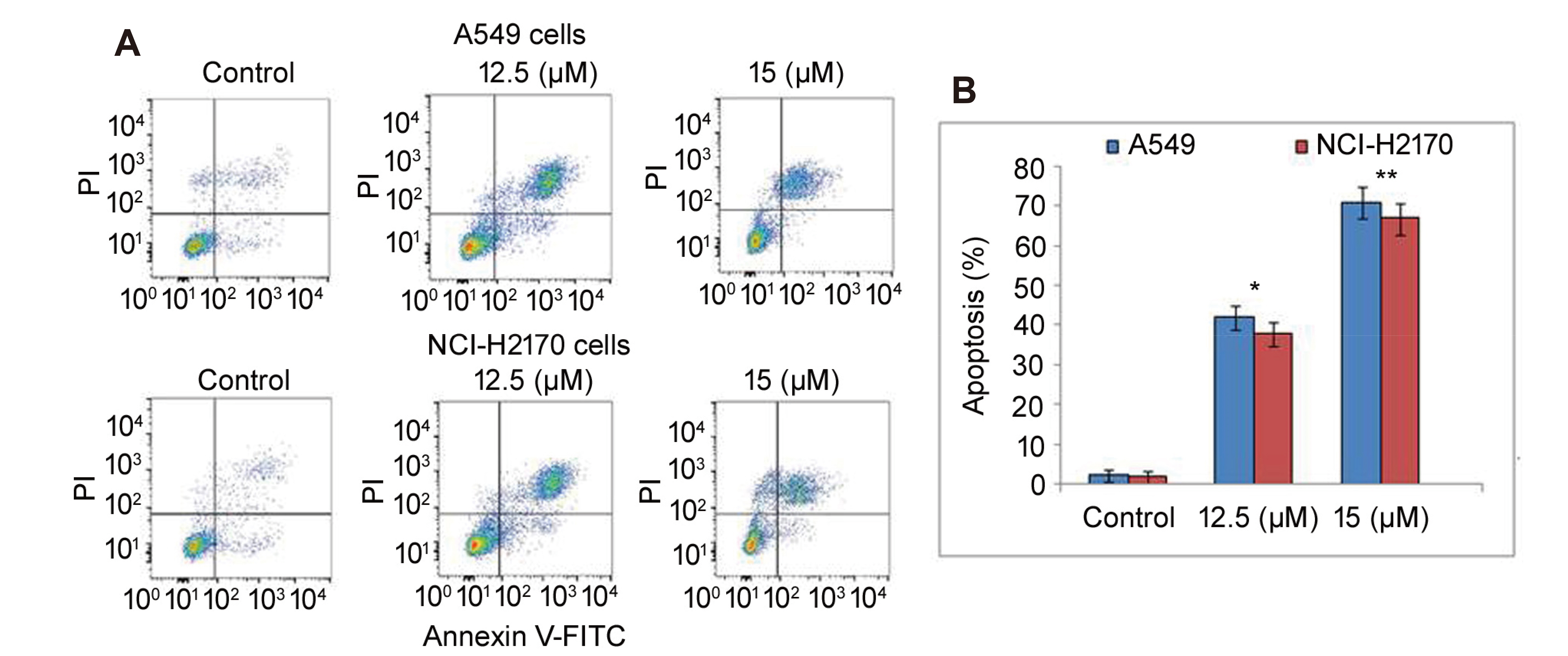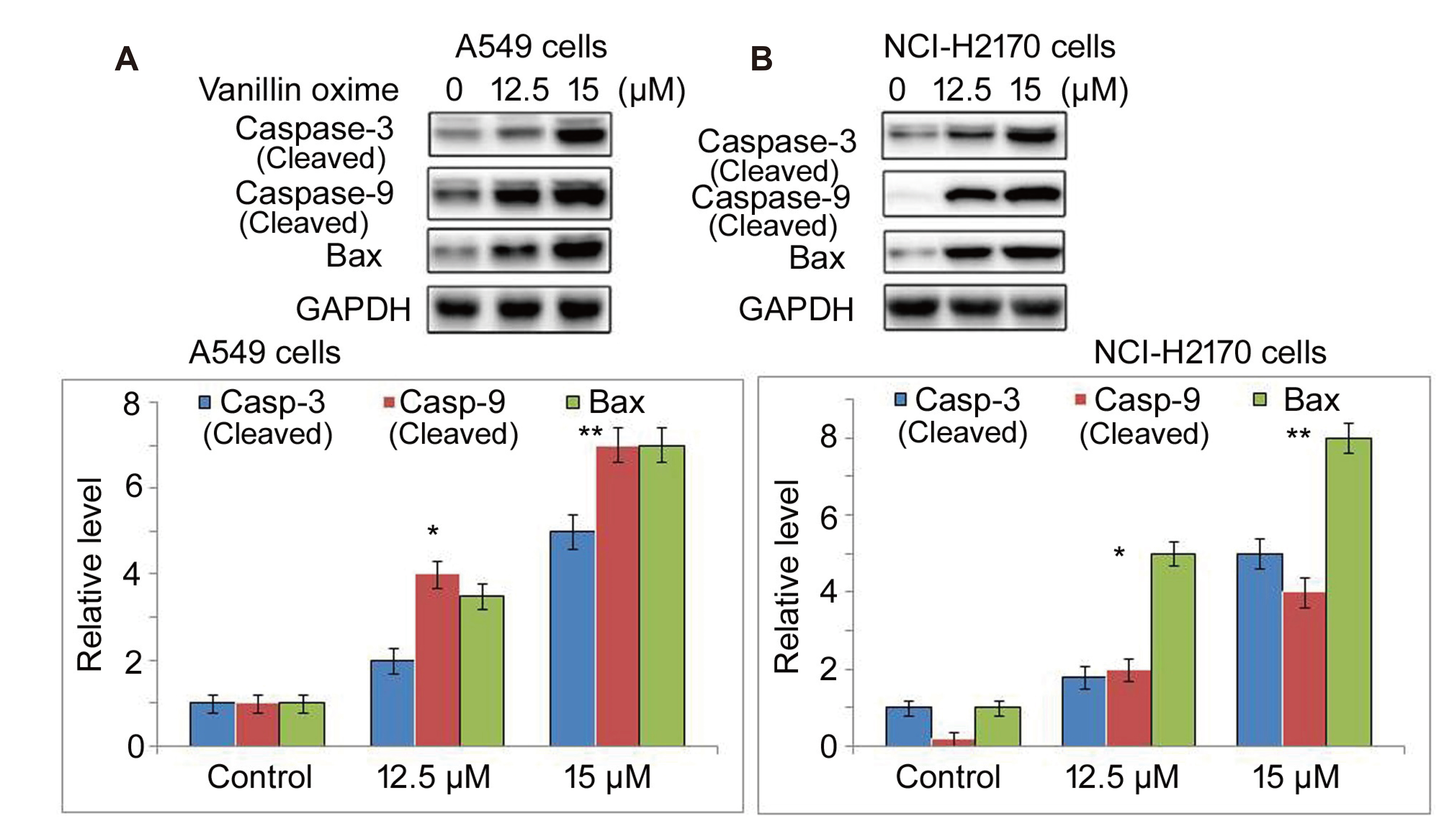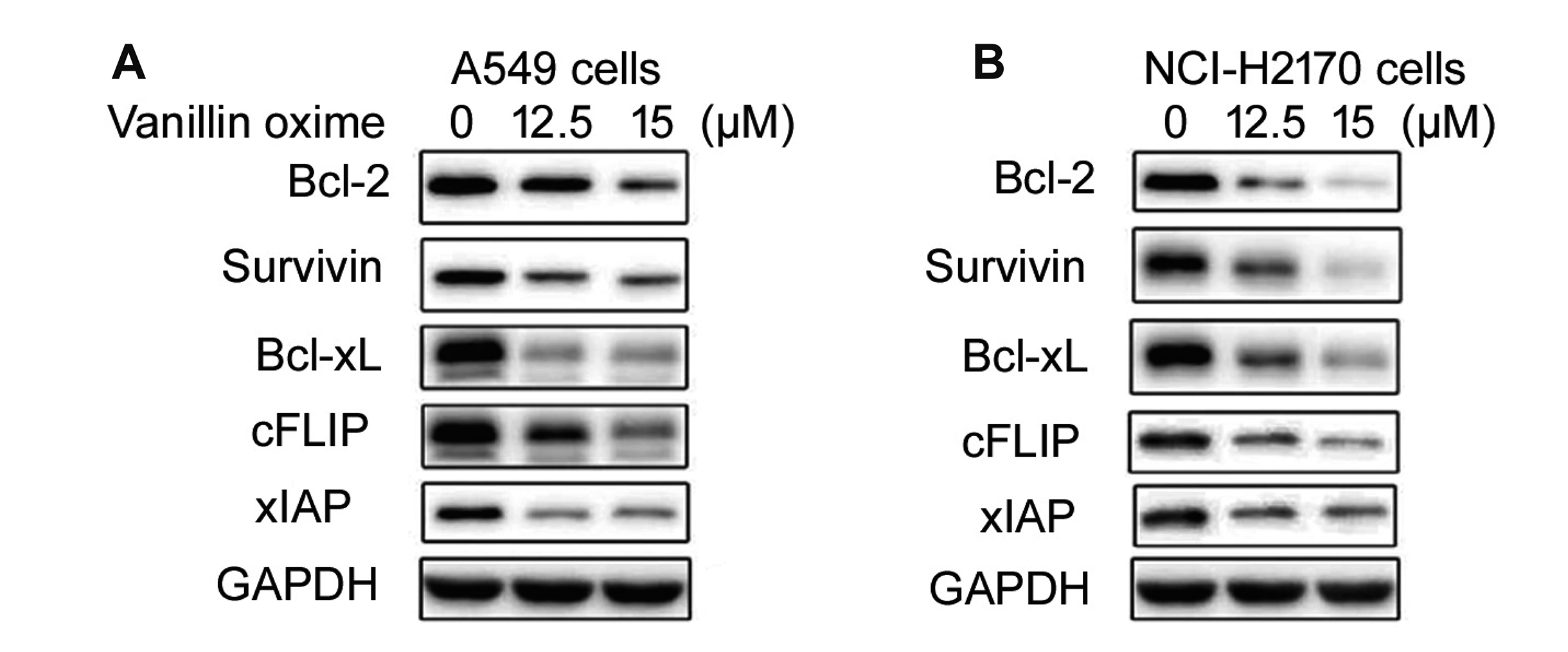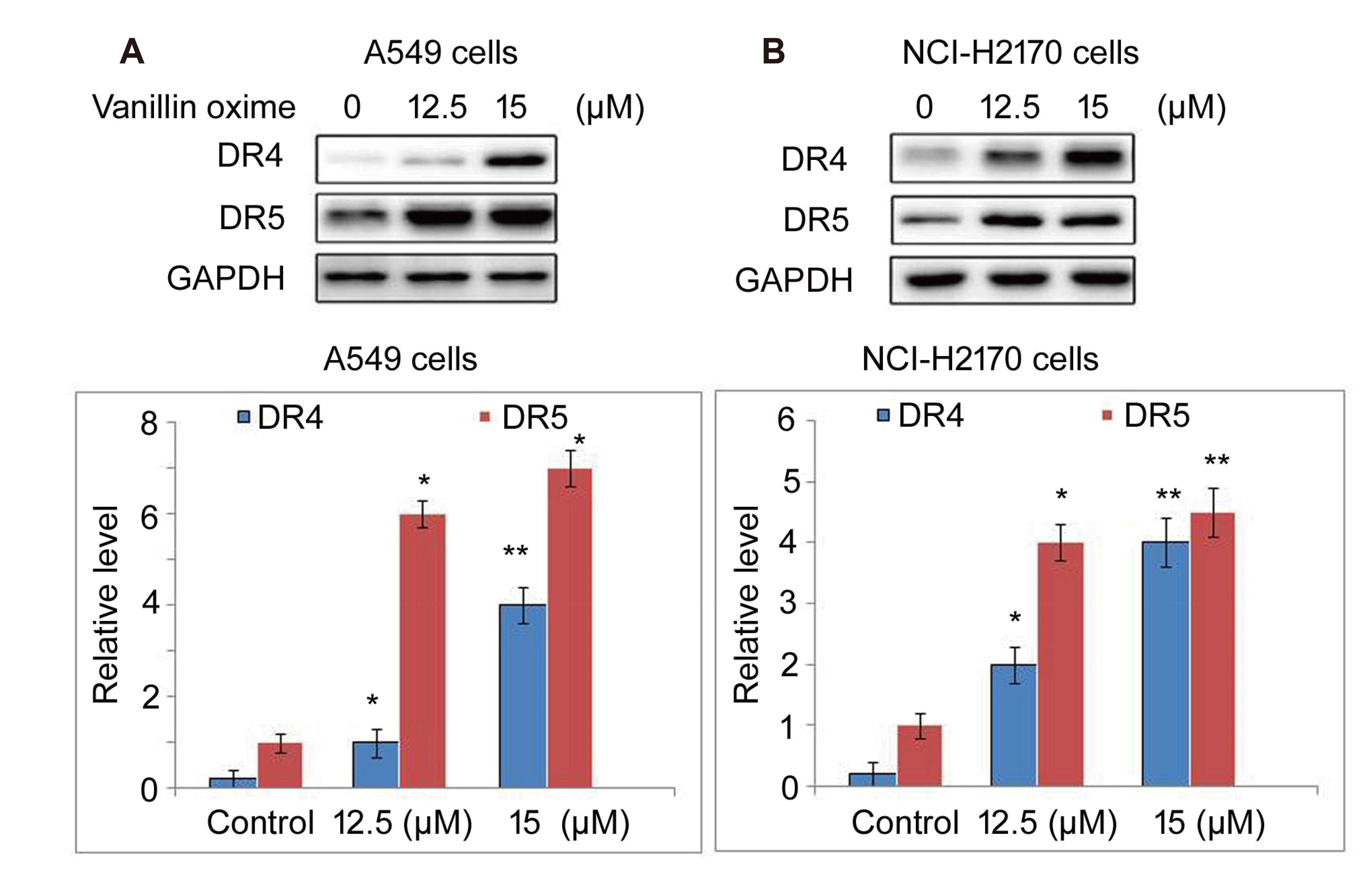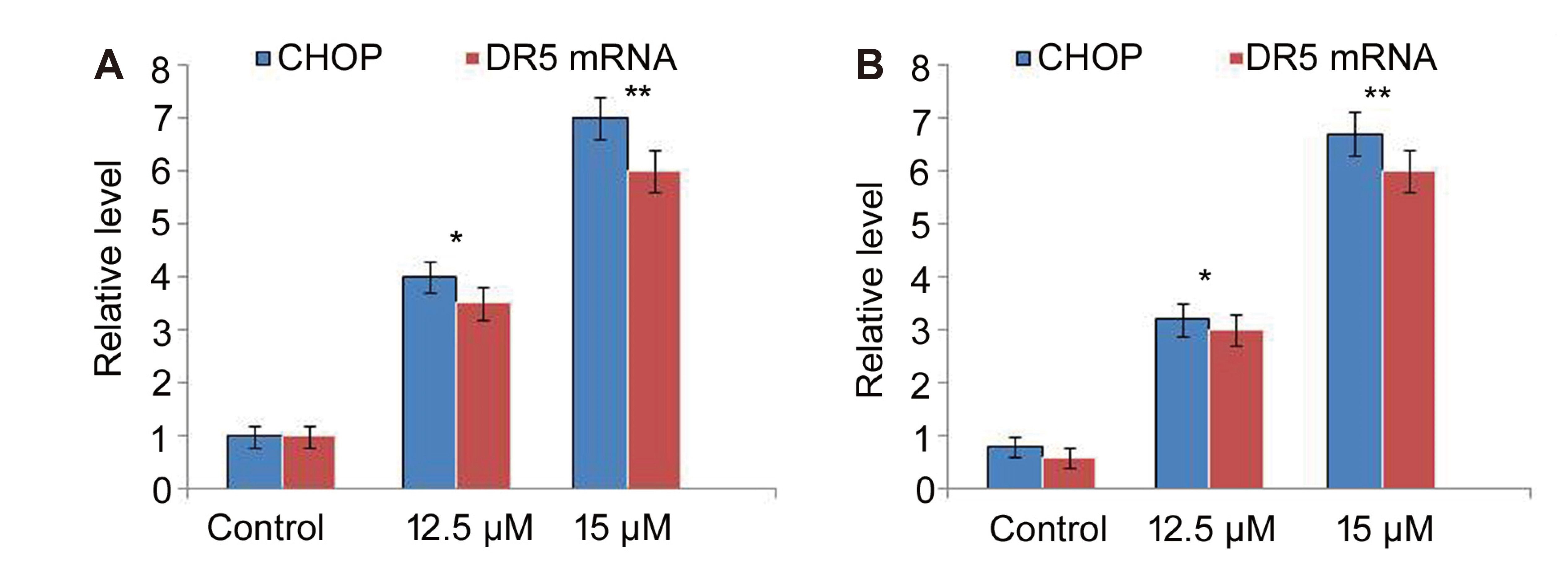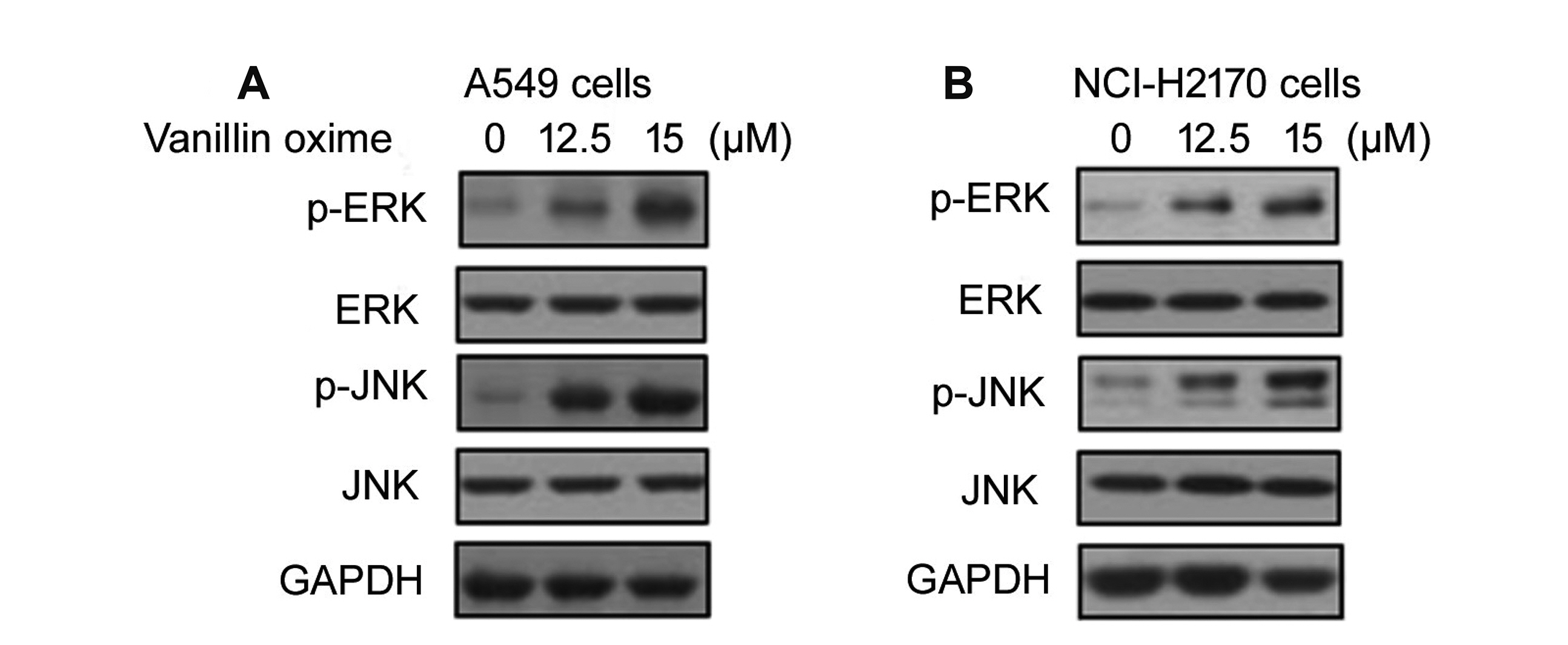Korean J Physiol Pharmacol.
2021 Jul;25(4):273-280. 10.4196/kjpp.2021.25.4.273.
Vanillin oxime inhibits lung cancer cell proliferation and activates apoptosis through JNK/ERK-CHOP pathway
- Affiliations
-
- 1Department of Respiratory, Yan'an People's Hospital, Yan'an, Shaanxi 716000, China
- 2Department of Medical Oncology Hospital Unit 3, Shaanxi Provincial Cancer Hospital, Xian 710061, China
- KMID: 2516867
- DOI: http://doi.org/10.4196/kjpp.2021.25.4.273
Abstract
- Lung cancer despite advancement in the medical field continues to be a major threat to human lives and accounts for a high proportion of fatalities caused by cancers globally. The current study investigated vanillin oxime, a derivative of vanillin, against lung cancer cells for development of treatment and explored the mechanism. Cell viability changes by vanillin oxime were measured using MTT assay. Vanillin oxime-mediated apoptosis was detected in A549 and NCI-H2170 cells at 48 h of exposure by flow cytometry. The CEBP homologous protein (CHOP) and death receptor 5 (DR5) levels were analysed by RT-PCR and protein levels by Western blotting. Vanillin oxime in concentration-dependent way suppressed A549 and NCI-H2170 cell viabilities. On exposure to 12.5 and 15 μM concentrations of vanillin oxime elevated Bax, caspase-3, and -9 levels in A549 and NCI-H2170 cells were observed. Vanillin oxime exposure suppressed levels of Bcl-2, survivin, Bcl-xL, cFLIP, and IAPs proteins in A549 and NCI-H2170 cells. It stimulated significant elevation in DR4 and DR5 levels in A549 and NCI-H2170 cells. In A549 and NCI-H2170 cells vanillin oxime exposure caused significant (p < 0.05) enhancement in CHOP and DR5 mRNA expression. Vanillin oxime exposure of A549 and NCI-H2170 cells led to significant (p < 0.05) enhancement in levels of phosphorylated extracellular-signal-regulated kinase and c-Jun N-terminal kinase. Thus, vanillin oxime inhibits pulmonary cell proliferation via induction of apoptosis through tumor necrosis factor-related apoptosis-inducing ligand (TRAIL) mediated pathway. Therefore, vanillin oxime may be studied further to develop a treatment for lung cancer.
Figure
Reference
-
1. Siegel R, Ma J, Zou Z, Jemal A. 2014; Cancer statistics, 2014. CA Cancer J Clin. 64:9–29. DOI: 10.3322/caac.21208. PMID: 24399786.
Article2. Herbst RS, Heymach JV, Lippman SM. 2008; Lung cancer. N Engl J Med. 359:1367–1380. DOI: 10.1056/NEJMra0802714. PMID: 18815398.
Article3. Brambilla E, Gazdar A. 2009; Pathogenesis of lung cancer signalling pathways: roadmap for therapies. Eur Respir J. 33:1485–1497. DOI: 10.1183/09031936.00014009. PMID: 19483050. PMCID: PMC2762943.
Article4. Ashkenazi A, Pai RC, Fong S, Leung S, Lawrence DA, Marsters SA, Blackie C, Chang L, McMurtrey AE, Hebert A, DeForge L, Koumenis IL, Lewis D, Harris L, Bussiere J, Koeppen H, Shahrokh Z, Schwall RH. 1999; Safety and antitumor activity of recombinant soluble Apo2 ligand. J Clin Invest. 104:155–162. DOI: 10.1172/JCI6926. PMID: 10411544. PMCID: PMC408479.
Article5. Sheridan JP, Marsters SA, Pitti RM, Gurney A, Skubatch M, Baldwin D, Ramakrishnan L, Gray CL, Baker K, Wood WI, Goddard AD, Godowski P, Ashkenazi A. 1997; Control of TRAIL-induced apoptosis by a family of signaling and decoy receptors. Science. 277:818–821. DOI: 10.1126/science.277.5327.818. PMID: 9242611.
Article6. Pan G, Ni J, Wei YF, Yu G, Gentz R, Dixit VM. 1997; An antagonist decoy receptor and a death domain-containing receptor for TRAIL. Science. 277:815–818. DOI: 10.1126/science.277.5327.815. PMID: 9242610.
Article7. Emery JG, McDonnell P, Burke MB, Deen KC, Lyn S, Silverman C, Dul E, Appelbaum ER, Eichman C, DiPrinzio R, Dodds RA, James IE, Rosenberg M, Lee JC, Young PR. 1998; Osteoprotegerin is a receptor for the cytotoxic ligand TRAIL. J Biol Chem. 273:14363–14367. DOI: 10.1074/jbc.273.23.14363. PMID: 9603945.
Article8. Nagata S. 1997; Apoptosis by death factor. Cell. 88:355–365. DOI: 10.1016/S0092-8674(00)81874-7.
Article9. Zhang L, Fang B. 2005; Mechanisms of resistance to TRAIL-induced apoptosis in cancer. Cancer Gene Ther. 12:228–237. DOI: 10.1038/sj.cgt.7700792. PMID: 15550937.
Article10. Sanlioglu AD, Dirice E, Aydin C, Erin N, Koksoy S, Sanlioglu S. 2005; Surface TRAIL decoy receptor-4 expression is correlated with TRAIL resistance in MCF7 breast cancer cells. BMC Cancer. 5:54. DOI: 10.1186/1471-2407-5-54. PMID: 15916713. PMCID: PMC1156874.
Article11. Griffith TS, Kucaba TA, O'Donnell MA, Burns J, Benetatos C, McKinlay MA, Condon S, Chunduru S. 2011; Sensitization of human bladder tumor cells to TNF-related apoptosis-inducing ligand (TRAIL)-induced apoptosis with a small molecule IAP antagonist. Apoptosis. 16:13–26. DOI: 10.1007/s10495-010-0535-3. PMID: 20734142.
Article12. Walton NJ, Mayer MJ, Narbad A. 2003; Vanillin. Phytochemistry. 63:505–515. DOI: 10.1016/S0031-9422(03)00149-3. PMID: 12809710.
Article13. King AA, Shaughnessy DT, Mure K, Leszczynska J, Ward WO, Umbach DM, Xu Z, Ducharme D, Taylor JA, Demarini DM, Klein CB. 2007; Antimutagenicity of cinnamaldehyde and vanillin in human cells: global gene expression and possible role of DNA damage and repair. Mutat Res. 616:60–69. DOI: 10.1016/j.mrfmmm.2006.11.022. PMID: 17178418. PMCID: PMC1955325.
Article14. inivasan K Sr, Platel K, Rao MVL. 2008; Hypotriglyceridemic effect of dietary vanillin in experimental rats. Eur Food Res Technol. 228:103–108. DOI: 10.1007/s00217-008-0911-1.
Article15. Imanishi H, Sasaki YF, Matsumoto K, Watanabe M, Ohta T, Shirasu Y, Tutikawa K. 1990; Suppression of 6-TG-resistant mutations in V79 cells and recessive spot formations in mice by vanillin. Mutat Res. 243:151–158. DOI: 10.1016/0165-7992(90)90038-L. PMID: 2304483.
Article16. Liang JA, Wu SL, Lo HY, Hsiang CY, Ho TY. 2009; Vanillin inhibits matrix metalloproteinase-9 expression through down-regulation of nuclear factor-kappaB signaling pathway in human hepatocellular carcinoma cells. Mol Pharmacol. 75:151–157. DOI: 10.1124/mol.108.049502. PMID: 18835982.17. Lirdprapamongkol K, Sakurai H, Suzuki S, Koizumi K, Prangsaengtong O, Viriyaroj A, Ruchirawat S, Svasti J, Saiki I. 2010; Vanillin enhances TRAIL-induced apoptosis in cancer cells through inhibition of NF-kappaB activation. In Vivo. 24:501–506. PMID: 20668316.18. Lirdprapamongkol K, Sakurai H, Kawasaki N, Choo MK, Saitoh Y, Aozuka Y, Singhirunnusorn P, Ruchirawat S, Svasti J, Saiki I. 2005; Vanillin suppresses in vitro invasion and in vivo metastasis of mouse breast cancer cells. Eur J Pharm Sci. 25:57–65. DOI: 10.1016/j.ejps.2005.01.015. PMID: 15854801.
Article19. Lirdprapamongkol K, Kramb JP, Suthiphongchai T, Surarit R, isomsap C Sr, Dannhardt G, Svasti J. 2009; Vanillin suppresses metastatic potential of human cancer cells through PI3K inhibition and decreases angiogenesis in vivo. J Agric Food Chem. 57:3055–3063. DOI: 10.1021/jf803366f. PMID: 19368348.
Article20. Yadav VR, Sung B, Prasad S, Kannappan R, Cho SG, Liu M, Chaturvedi MM, Aggarwal BB. 2010; Celastrol suppresses invasion of colon and pancreatic cancer cells through the downregulation of expression of CXCR4 chemokine receptor. J Mol Med. 88:1243–1253. DOI: 10.1007/s00109-010-0669-3. PMID: 20798912. PMCID: PMC3142743.
Article21. Tsuda H, Uehara N, Iwahori Y, Asamoto M, Iigo M, Nagao M, Matsumoto K, Ito M, Hirono I. 1994; Chemopreventive effects of beta-carotene, alpha-tocopherol and five naturally occurring antioxidants on initiation of hepatocarcinogenesis by 2-amino-3-methylimidazo [4,5-f]quinoline in the rat. Jpn J Cancer Res. 85:1214–1219. DOI: 10.1111/j.1349-7006.1994.tb02932.x. PMID: 7852184. PMCID: PMC5919387.22. Durant S, Karran P. 2003; Vanillins--a novel family of DNA-PK inhibitors. Nucleic Acids Res. 31:5501–5512. DOI: 10.1093/nar/gkg753. PMID: 14500812. PMCID: PMC206453.
Article23. Gustafson DL, Franz HR, Ueno AM, Smith CJ, Doolittle DJ, Waldren CA. 2000; Vanillin (3-methoxy-4-hydroxybenzaldehyde) inhibits mutation induced by hydrogen peroxide, N-methyl-N-nitrosoguanidine and mitomycin C but not (137)Cs gamma-radiation at the CD59 locus in human-hamster hybrid A(L) cells. Mutagenesis. 15:207–213. DOI: 10.1093/mutage/15.3.207. PMID: 10792012.
Article24. Chawla-Sarkar M, Bae SI, Reu FJ, Jacobs BS, Lindner DJ, Borden EC. 2004; Downregulation of Bcl-2, FLIP or IAPs (XIAP and survivin) by siRNAs sensitizes resistant melanoma cells to Apo2L/TRAIL-induced apoptosis. Cell Death Differ. 11:915–923. DOI: 10.1038/sj.cdd.4401416. PMID: 15118763.
Article25. Deveraux QL, Takahashi R, Salvesen GS, Reed JC. 1997; X-linked IAP is a direct inhibitor of cell-death proteases. Nature. 388:300–304. DOI: 10.1038/40901. PMID: 9230442.
Article26. Gupta SC, Reuter S, Phromnoi K, Park B, Hema PS, Nair M, Aggarwal BB. 2011; Nimbolide sensitizes human colon cancer cells to TRAIL through reactive oxygen species- and ERK-dependent up-regulation of death receptors, p53, and Bax. J Biol Chem. 286:1134–1146. Retraction. DOI: 10.1074/jbc.M110.191379. PMID: 21078664. PMCID: PMC3020720.
Article27. Moon DO, Park SY, Choi YH, Ahn JS, Kim GY. 2011; Guggulsterone sensitizes hepatoma cells to TRAIL-induced apoptosis through the induction of CHOP-dependent DR5: involvement of ROS-dependent ER-stress. Biochem Pharmacol. 82:1641–1650. DOI: 10.1016/j.bcp.2011.08.019. PMID: 21903093.
Article28. Fisher MJ, Virmani AK, Wu L, Aplenc R, Harper JC, Powell SM, Rebbeck TR, Sidransky D, Gazdar AF, El-Deiry WS. 2001; Nucleotide substitution in the ectodomain of trail receptor DR4 is associated with lung cancer and head and neck cancer. Clin Cancer Res. 7:1688–1697. PMID: 11410508.29. Mellier G, Huang S, Shenoy K, Pervaiz S. 2010; TRAILing death in cancer. Mol Aspects Med. 31:93–112. DOI: 10.1016/j.mam.2009.12.002. PMID: 19995571.
Article30. Lin N, Sato T, Takayama Y, Mimaki Y, Sashida Y, Yano M, Ito A. 2003; Novel anti-inflammatory actions of nobiletin, a citrus polymethoxy flavonoid, on human synovial fibroblasts and mouse macrophages. Biochem Pharmacol. 65:2065–2071. DOI: 10.1016/S0006-2952(03)00203-X. PMID: 12787887.
Article
- Full Text Links
- Actions
-
Cited
- CITED
-
- Close
- Share
- Similar articles
-
- The MicroRNA hsa-let-7g Promotes Proliferation and Inhibits Apoptosis in Lung Cancer by Targeting HOXB1
- Immunohistochemical Study on MAPK Expression in Seborrheic Keratosis and Squamous Cell Carcinoma by Sun Exposure
- The Mechanism of Proteasome Inhibitor-Induced Apoptosis in Lung Cancer Cells
- Synergistic effect of ERK inhibition on tetrandrine-induced apoptosis in A549 human lung carcinoma cells
- Effect and Mechanism Study of Sodium Houttuyfonate on Ventilator-Induced Lung Injury by Inhibiting ROS and Inflammation


